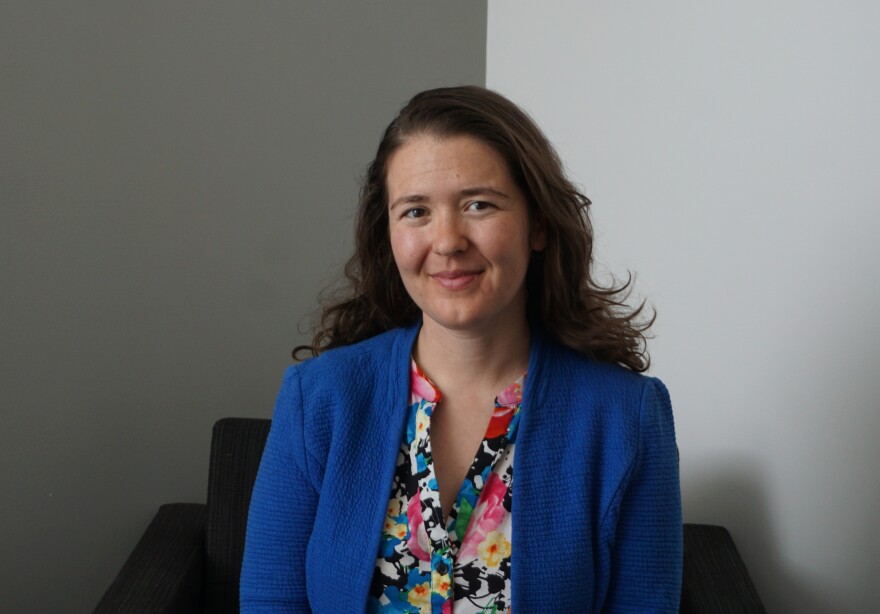Stretches of St. Louis’ busiest streets have long been busted with potholes the size of lobster pots. Yet with millions of dollars from the American Rescue Plan now set to be deployed for repaving projects, the city’s citizen-led Community Mobility Committee has an unexpected request for the mayor: Slow down.
It’s not that the committee is anti-car or pro-pothole.

“Dangerous streets are dangerous for everyone,” Liz Kramer, the committee’s chair, told St. Louis on the Air on Tuesday. “But some of the streets that are highlighted in that first round of funding don't have plans to improve pedestrian infrastructure, bicycle infrastructure, or bus infrastructure along with them.”
Established as an official advisory body to the city in 2020, the Community Mobility Committee focuses on making St. Louis’ streets, sidewalks and roadways safe and accessible for not just cars, but for pedestrians, cyclists, scooters, wheelchair users and public transit riders.
However, the repaving projects planned under a recent bill signed by Mayor Tishaura Jones — which designates $84 million in federal COVID relief funds to infrastructure — appear to replicate existing road design. The committee sees that as a missed opportunity.
In a May 9 letter to Jones, the committee urged the mayor “to consider the timing of repaving these segments” and to integrate plans that don’t just resurface the road, but make pedestrians a priority as well.
Said Kramer, “We want to make sure that we make the most of that investment, and think comprehensively about not just repaving, but how can we create ADA-accessible crosswalks? How can we have bike lanes that people truly want to ride on? And that are really improving the experience and calming the traffic on our streets?”
That sort of comprehensive planning is needed, she argues, in light of St. Louis’ dire trend in pedestrian deaths:After nearly doubling in 2020, pedestrian deaths remained high in 2021.
Kramer noted that the city and some neighborhoods are already involved in traffic planning projects that seek to improve street conditions. Those efforts, combined with existing traffic studies, should give the city a strong basis for approaching its busiest streets with more in mind than just a smoother surface.
Kramer suggested that traffic calming measures like curb extensions, high-visibility crosswalks and lane diets that reconfigure the road “can be much more efficiently put in if they're done at the same time as that fresh off asphalt going down.”
So far, Kramer says the committee has not received a response to its letter. Reached for comment Tuesday, a spokesman for the mayor’s office provided a written statement that noted the recent approval by the Board of Estimate and Apportionment of $250,000 toward a citywide traffic calming and pedestrian safety study.
The city’s statement also drew attention to the Louisiana Calm Streets pilot project, the first such project undertaken by the city, which is funded by both federal and ward capital dollars. The project’s goal is to slow traffic from Gravois Avenue to Meramec Street, and involves installing curb ramps and sidewalks near Marquette Park, along with pinch points, traffic circles and sidewalk replacement.
But the committee hopes the city expands the scope for those sorts of measures, particularly on pedestrian-unfriendly roads like Grand, Kingshighway, Jefferson, Union and Goodfellow — all of which are scheduled for resurfacing under the bill Jones signed earlier this month.
Along with the mayor, Kramer recently participated in a Neighborhood Transformation roundtable to discuss the city’s transit needs. Kramer says she came away from the meeting optimistic about the administration’s trajectory, particularly in the way it’s focusing on improving transit systems, not just specific streets.
Still, Kramer and the committee hope that more can be done for pedestrians and others sharing the road — before federal COVID relief dollars are exhausted.
“We have a lot of needs in our city,” Kramer said. “[Jones’] systems approach, and the way that the city thinks about systems, I think is so critical to improving transportation, infrastructure and safety for everyone.”
“St. Louis on the Air” brings you the stories of St. Louis and the people who live, work and create in our region. The show is hosted by Sarah Fenske and produced by Emily Woodbury, Kayla Drake, Danny Wicentowskiand Alex Heuer. Jane Mather-Glass is our production assistant. The audio engineer is Aaron Doerr.







